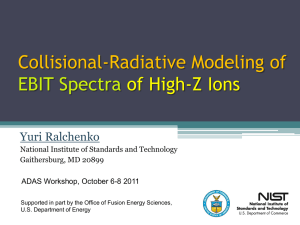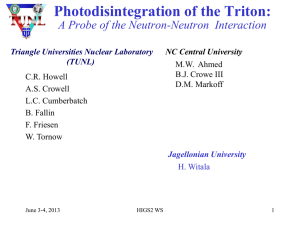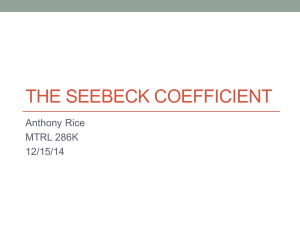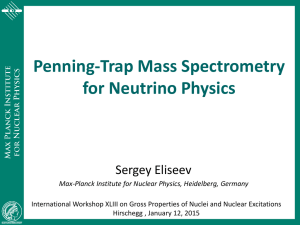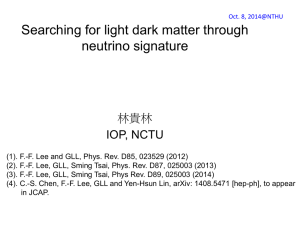Halo World: The Story according to Faddeev, Efimov
advertisement
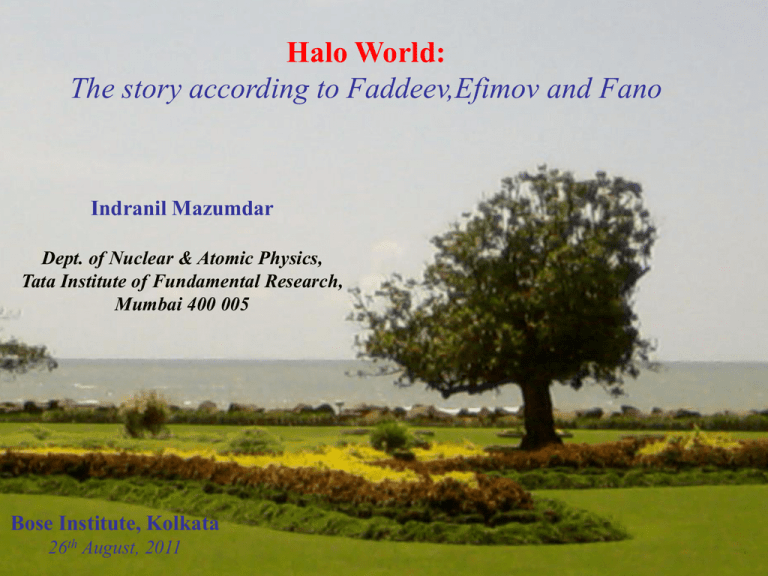
Halo World: The story according to Faddeev,Efimov and Fano Indranil Mazumdar Dept. of Nuclear & Atomic Physics, Tata Institute of Fundamental Research, Mumbai 400 005 Bose Institute, Kolkata 26th August, 2011 Halo Nuclei: Exotic Structures and exotic effects Plan of the talk Introduction to Nuclear Halos Three-body model of 2-n Halo nucleus probing the structural properties of 11Li Efimov effect in 2-n halo nuclei Fano resonances of Efimov states Probing few other candidates: The Experimental Angle Summary and future scope Collaborators • V.S. Bhasin Delhi Univ. • V. Arora Delhi Univ. • A.R.P. Rau Louisiana State Univ. •Phys. Rev. Lett. 99, 269202 •Nucl. Phys. A790, 257 •Phys. Rev. Lett. 97, 062503 •Phys. Rev. C69, 061301(R) •Phys. Rev. C61, 051303(R) •Phys. Rev. C56, R5 •Phys. Rev. C50 , R550 •Few Body Systems, 2009 •Pramana, 2010 •Phys. Lett. B (In press) Phys. Rep 212 (1992) J.M. Richard Phys. Rep. 231 (1993) 151(Zhukov et al.) Phys. Rep. 347 (2001) 373 (Nielsen et al.) Prog. Part. Nucl. Phys. 47,517 (2001) (Brown) Rev. Mod. Phys. 76,(2004) 215(Jensen et al.) Phys. Rep. 428, (2006) 259(Braaten & Hammer) Ann Rev. Nucl. Part. Sci. 45, 591(Hansen et al.) Rev. Mod. Phys. 66 (1105)(K. Riisager) Known nuclei terra incognita R = ROA1/3 Stable Nuclei R = R0 A1/3 Shell Structure Magic Numbers 208Pb 11Li Advent of Radioactive Ion Beams Interaction cross section measurements I /IO = e-srt sI = p[RI(P) + RI(T)]2 R = R0 A1/3 Shell Structure Magic Numbers 208Pb 11Li Pygmy Resonance PDR in 68Ni O. Wieland et. al. PRL 102 , 2009 “The neutron halo of extremely neutron rich nuclei” Europhys.Lett. 4, 409 (1987) P.G.Hansen, B.Jonson Exotic Structure of 2-n Halo Nuclei 11Li Z=3 N=8 Radius ~3.2 fm S2n = 369.15 (0.65) keV Accepted lifetime: Jp = 3/28.80 (0.14) ms S2n = 12.2 MeV for 18O Typical experimental momentum distribution of halo nuclei from fragmentation reaction Kobayashi et al., PRL 60, 2599 (1988) TRIUMF, Canada RIBF, RIKEN JAEA, Tokai HIMAC, Chiba CYRIC, Tohoku RCNP, Osaka GSI, Darmstadt SPIRAL, Ganil HIRF, Lanzhou CIAE, Beijing FRIB, MSU ATLAS, ANL HRIBF, Oak Ridge FLNR-JINR, Dubna Vecc, Kolkata Production Mechanisms •ISOL •In-Flight projectile fragmentation Courtesy: V. Oberacker, Vanderbilt Univ. H. Sakurai, NIM-B (2008) Neutron skin Theoretical Models • Shell Model Bertsch et al. (1990) PRC 41,42, Kuo et al. PRL 78,2708 (1997) 2 frequency shell model Brown (Prog. Part. Nucl. Physics 47 (2001) Talmi & Unna, PRL 4, 496 (1960) 11Be Ab initio no-core full configuration calculation of light nuclei Navratil, Vary, Barrett PRL84(2000), PRL87(2001) Quantum Monte Carlo Calculations of Light Nuclei: 4,6,8 Pieper, Wiringa • Cluster model • Three-body model ( for 2n halo nuclei ) • RMF model • EFT Braaten & Hammer, Phys. Rep. 428 (2006) He, Sn = 820 keV Sn = 504 keV Audi & Wapstra (2003) 6,7Li, 8,9,10 Be 2010: The Golden Jubilee year of Faddeev Equations. L.D. Faddeev, Zh. Eksperim, I Teor. Fiz. 39, 1459 (1960) S. Weinberg, Phys. Rev. 133, B232 (1964) C. Lovelace: Phys. Rev. 135, No. 5B B1225 (1964) J. G. Taylor, Nuovo Cimento (1964) L. Rosenberg, Phys. Rev 135, B715 (1964) Ludwig Dmitrievich Faddeev A.N. Mitra, Nucl. Phys. 32, 529 (1962) LD Faddeev AN Mitra NN Interaction & Nuclear Many-Body Problem Nov. 17 – 26, 2010, TIFR Dasgupta, Mazumdar, Bhasin, Phys. Rev C50,550 We Calculate •2-n separation energy •Momentum distribution of n & core •Root mean square radius Inclusion of p-state in n-core interaction b-decay of 11Li The rms radius rmatter calculated is ~ 3.6 fm <r2>matter = Ac/A<r2>core + 1/A<r2> r2 = r2nn + r2nc Dasgupta, Mazumdar, Bhasin PRC50, R550 Fedorov et al (1993) Garrido et al (2002) (3.2 fm) Dasgupta, Mazumdar, Bhasin, PRC 50, R550 Data: Ieki et al, PRL 70 ,1993 2-particle correlations: Hagino et al , PRC, 2009 11Li Vs 6He 11Li 6He 11Li is different from 6He •Strong influence of virtual s-state n-core interaction in 11Li Efimov effect: To Efimov Physics “ From questionable to pathological to exotic to a hot topic …” Nature Physics 5, 533 (2009) Vitaly Efimov Univ. of Washington, Seattle 2010: The 40th year of a remarkable discovery Belyaev, Faddeev, Efimovs Nov. 2010, TIFR Efimov, 1990 Ferlaino & Grimm 2010 V. Efimov: Theoretical searches in Atomic Systems Sov. J. Nucl. Phys 12, 589 (1971) Phys. Lett. 33B (1970) Nucl. Phys A 210 (1973) Comments Nucl. Part. Phys.19 (1990) T.K. Lim et al. PRL38 (1977) Amado & Noble: The case of He trimer Cornelius & Glockle, J. Chem Phys. 85 (1986) T. Gonzalez-Lezana et al. PRL 82 (1999), Phys. Lett. 33B (1971) Phys. Rev. D5 (1972) Fonseca et al. Nucl. PhysA320, (1979) Adhikari & Fonseca Diffraction experiments with transmission gratings Carnal & Mlynek, PRL 66 (1991) Hegerfeldt & Kohler, PRL 84, (2000) Phys. Rev D24 (1981) Three-body recombination in ultra cold atoms L.H. Thomas, Phys.Rev.47,903(1935) First Observation of Efimov States Letter Nature 440, 315-318 (16 March 2006) | Evidence for Efimov quantum states in an ultracold gas of caesium atoms T. Kraemer, M. Mark, P. Waldburger, J. G. Danzl, C. Chin, B. Engeser, A. D. Lange, K. Pilch, A. Jaakkola, H.-C. Nägerl and R. Grimm Magnetic tuning of the two-body interaction • For Cs atoms in their energetically lowest state the s-wave scattering length a varies strongly with the magnetic field. Trap set-ups and preparation of the Cs gases • All measurements were performed with trapped thermal samples of caesium atoms at temperatures T ranging from 10 to 250 nK. • In set-up A they first produced an essentially pure Bose–Einstein condensate with up to 250,000 atoms in a far-detuned crossed optical dipole trap generated by two 1,060-nm Yb-doped fibre laser beams • In set-up B they used an optical surface trap in which they prepared a thermal sample of 10,000 atoms at T 250 nK via forced evaporation at a density of n0 = 1.0 1012 cm-3. The dipole trap was formed by a repulsive evanescent laser wave on top of a horizontal glass prism in combination with a single horizontally confining 1,060-nm laser beam propagating along the vertical direction T. Kraemer et al. Nature 440, 315 Observation of an Efimov spectrum in an atomic system. M. Zaccanti et al. Nature Physics 5, 586 (2009) • System composed of ultra-cold potassium atoms (39K) with resonantly tunable two-body interaction. • Atom-dimer resonance and loss mechanism • Large values of a up to 25,000 ao reached. • First two states of an Efimov spectrum seen Can we find Efimov Effect in the atomic nucleus? Unlike cold atom experiments we have no control over the scattering lengths. The discovery of 2-neutron halo nuclei, characterized by very low separation energy and large spatial extension are ideally suited for studying Efimov effect in atomic nuclei. Fedorov & Jensen PRL 71 (1993) Conditions for occurrence of Efimov states in 2-n halo nuclei. Fedorov, Jensen, Riisager PRL 73 (1994) P. Descouvement PRC 52 (1995), Phys. Lett. B331 (1994) tn-1(p)F(p) ≡ f(p) and tc-1(p)G(p) ≡ c(p) Where The basic structure of the equations in terms of the spectator functions F(p) and G(p) remains same. But for the sensitive computational details of the Efimov effect we recast the equations in dimensionless quantities. tn-1(p) = mn-1 – [ br (br + √p2/2a + e3)2 ]-1 tc-1(p) = mc-1 – 2a[ 1+ √2a(p2/4c + e3) ]-2 where mn = p2ln/b12 and mc = p2lc/2ab13 are the dimensionless strength parameters. Variables p and q in the final integral equation are also now dimensionless, p/b1 p & q/b1 q and -mE/b13 = e3, br = b/b1 Factors tn-1 and tc-1 appear on the left hand side of the spectator functions F(p) and G(p) and are quite sensitive. They blow up as p 0 and e3 approaches extremely small value. Mazumdar and Bhasin, PRC 56, R5 First Evidence for low lying s-wave strength in 13Be Fragmentation of 18O, virtual state with scattering length < 10 fm Thoennessen, Yokoyama, Hansen Phys. Rev. C 63, 014308 Mazumdar, Arora Bhasin Phys. Rev. C 61, 051303(R) • The feature observed can be attributed to the singularity in the two body propagator [LC-1 – hc(p)]-1. • There is a subtle interplay between the two and three body energies. • The effect of this singularity on the behaviour of the scattering amplitude has to be studied. For k 0, the singularity in the two body cut Does not cause any problem. The amplitude has only real part. The off-shell amplitude is computed By inverting the resultant matrix , which in the limit ao(p)p0 -a, the n-19C scattering length. For non-zero incident energies the singularity in the two body propagator is tackled by the CSM. P p1e-if and q qe-if The unitary requirement is the Im(f-1k) = -k Balslev & Combes (1971) Matsui (1980) Volkov et al. n-18C Energy e3(0) (keV) (MeV) e3(1) (keV) 60 100 140 180 220 240 250 300 79.5 66.95 116.6 101.4 152.0 137.5 186.6 ----221.0 ----238.1 --------------------- 3.00 3.10 3.18 3.25 3.32 3.35 3.37 3.44 e3(2) (keV) Arora, Mazumdar,Bhasin, PRC 69, 061301 Ugo Fano (1912 – 2001) Third highest in citation impact of all papers published in the entire Physical Review series. Fitting the Fano profile to the N-19C elastic cross section for n-18C BE of 250 keV s = so[(q + e)2/(1+e2)] Mazumdar, Rau, Bhasin Phys. Rev. Lett. 97 (2006) an ancient pond a frog jumps in a deep resonance The resonance due to the second excited Efimov state for n-18C BE 150 keV. The profile is fitted by same value of q as for the 250 keV curve. Comparison between He and 20C as three body Systems in atoms and nuclei Discussion •We emphasize the cardinal role of channel coupling. There is also a definite role of mass ratios as observed numerically. •However, channel coupling is an elegant and physically plausible scenario. •Difference can arrive between zero range and realistic finite range potentials in non-Borromean cases. Note, that for n-18C binding energy of 200 keV, the scattering length is about 10 fm while the interaction range is about 1 fm. •The extension of zero range to finer details of Efimov states in non-Borromean cases may not be valid. •The discrepancy observed in the resonance vs virtual states in 20C clearly underlines the sensitive structure of the three-body scattering amplitude derived from the binary interactions. The calculation have been extended to 1) Two hypothetical cases: very heavy core of mass A = 100 (+ 2n) three equal masses m1=m2=m3 2) Two realistic cases of 38Mg 32Ne 38Mg 38Mg & 32Ne S2n = 2570 keV n + core (37Mg) 250 keV (bound) S2n = 1970 keV n + core (31Ne) 330 keV (bound) (S2n) Audi & Wapstra (2003) 37Mg & 31Ne (Sn) Sakurai et al., PRC 54 (1996), Jurado et al. PLB (2007), Nakamura et al. PRL (2009) We have reproduced the ground state energies and have found at least two Efimov states that vanish into the continuum with increasing n-core interaction. They again show up as asymmetric resonances at around 1.6 keV neutron incident energy in the scattering sector. Mazumdar, Bhasin, Rau Phys. Lett. B (In Press) eo Equal Heavy Core (keV) 250 (keV) 455 (keV) 4400 300 546 4470 350 637 4550 Ground states for the two cases •Equal mass case strikingly different from unequal ( heavy core ) case. •Evolution of Efimov states in heavy core of 100 fully consistent with 20C results. Mazumdar Few Body Systems, 2009 TABLE: Ground and excited states for three cases studied, namely, mass 102 (columns 2, 3, 4), 38Mg (column 5, 6, 7), and 32Ne (columns 8, 9, 10) for different two body input parameters. n-Core Energy e2 keV e3(0) keV 40 4020 60 e3(1) keV 32Ne 38Mg 102A e3(2) keV e3(0) keV e3(1) keV e3(2) keV e3(0) keV e3(1) keV e3(2) keV 53.6 44.4 3550 61.3 49.9 3420 61.5 50 4080 70.4 61.7 3610 80.8 67.1 3480 81.0 67.2 80 4130 86.9 (78.4) 3670 99.2 84.16 3530 99.8 84.3 100 4170 103.1 3710 117 101.4 3570 117.5 101.5 120 4220 (119.3) 3750 134.5 (118.9) 3620 135 (118.9) 140 4259 3790 151.6 3650 152.5 180 4345 3860 185.6 3730 186.5 250 4460 3980 3852 300 4530 4040 3910 350 4590 4120 3980 38Mg Heavy Core 4000 4000 sel(b) Core Mass = 100 e 2 = 250 keV e 2 = 250 keV e 2 = 250 keV 3500 32Ne 4000 3500 Core Mass = 36 3500 3000 3000 3000 2500 2500 2500 2000 2000 2000 1500 1500 1500 1000 1000 1000 500 500 500 0 0.0 0.5 1.0 1.5 2.0 2.5 3.0 3.5 4.0 3000 0 0.0 0.5 1.0 1.5 2.0 2.5 3.0 3.5 4.0 5000 e 2 = 150 keV e 2 = 150 keV Core Mass = 36 Core Mass = 100 Core Mass = 30 0 0.0 0.5 1.0 1.5 2.0 2.5 3.0 3.5 4.0 4000 e 2 = 150 keV 3500 Core Mass = 30 2500 4000 3000 2000 2500 3000 1500 2000 2000 1500 1000 1000 1000 500 500 0 0.0 0.5 1.0 1.5 2.0 2.5 3.0 3.5 4.0 Mazumdar, Bhasin, Rau Phys. Lett. B (In Press) 0 0.0 0.5 1.0 1.5 2.0 2.5 3.0 3.5 4.0 Ei (keV) 0 0.0 0.5 1.0 1.5 2.0 2.5 3.0 3.5 4.0 A possible experimental proposal to search for Efimov State in 2-neutron halo nuclei. •Production of 20C secondary beam with reasonable flux •Acceleration and Breakup of 20C on heavy target •Detection of the neutrons and the core in coincidence •Measurement of g-rays as well The Arsenal: • Neutron detectors array • Gamma array • Charged particle array Another experimental scenario: 19C beam on deuteron target: Neutron stripping reaction Summary A three body model with s-state interactions account for most of the gross features of 11Li in a reasonable way. Inclusion of p-state in the n-9Li contributes marginally. A virtual state of a few keV (2 to 4) energy corresponding to scattering length from -50 to -100 fm for the n-12Be predicts the ground state and excited states of 14Be. 19B, 22C and 20C are investigated and it is shown that Borromean type nuclei are much less vulnerable to respond to Efimov effect 20C is a promising candidate for Efimov states at energies below the n-(nc) breakup threshold. The bound Efimov states in 20C move into the continuum and reappear as Resonances with increasing strength of the binary interaction. Asymmetric resonances in elastic n+19C scattering are attributed to Efimov states and are identified with the Fano profile. The conjunction of Efimov and Fano phenomena my lead to the experimental realization in nuclei. Present Activities: Resonant states above the three body breakup threshold in 20C. Structure calculations for 12Be Fano resonances of Efimov states in 16C, 19B, 22C and analytical derivation of the Fano index q. Role of Efimov states in Bose-Einstein condensation. Studying the proton halo (17Ne) nucleus. three charged particle, Belyaev, Shlyk, NPA 790 (2007) Reanalyze profiles of GDR on ground states for its asymmetry. Planning for possible experiments with 20C beam Epilogue “ the richness of undestanding reveals even greater richness of ignorance” D.H. Wilkinson THANK YOU Kumar & Bhasin, Phys. Rev. C65 (2002) Incorporation of both s & p waves in n-9Li potential •Ground state energy and 3 excited states above the 3-body breakup threshold were predicted Er (T) •The resulting coupled integral equations for the spectator functions have been computed using the method of rotating the integral contour of the kernels in the complex plane. •Dynamical content of the two body input potentials in the three body wave function has also been analyzed through the three-dimensional plots. Er (Ex) G (T) 0.038 0.03(0.04) 0.056 1.064 1.02(0.07) 0.050 2.042 2.07(0.12) 0.500 Data from Gornov et al. PRL81 (1998) b-decay to two channels studied: 11Li to high lying excited state of 11Be 11Li to 9Li + deuteron channel 18.3 MeV, bound (9Li+p+n) system Gamow-Teller b-decay strength calculated Branching ratio (1.3X10-4) calculated Mukha et al (1997), Borge et al (1997) Kumar & Bhasin PRC65, (2002) Appearance of Resonance in n-19 C Scattering • The equation for the off-shell scattering amplitude in n-19 C ( bound state of n-18 C) can be written as • where a k(p) is the off-shell scattering amplitude, normalized such that • In the present model, the singularity in the present model appears in the two body propagator L - h ( p ) = ( p 2 d -1 -1 c c 2 2 3 - d / a ) h( p , ; ) 2 2 2 2 2 2 3 -1

